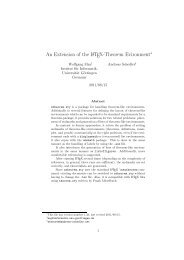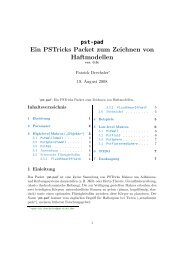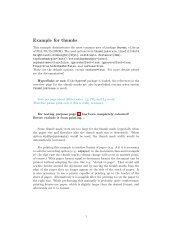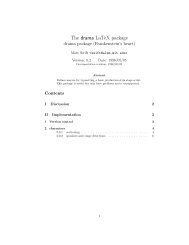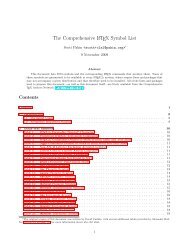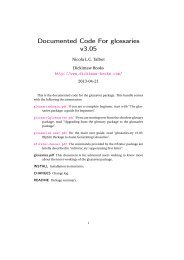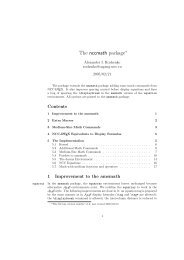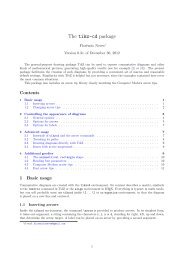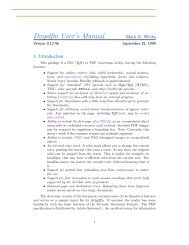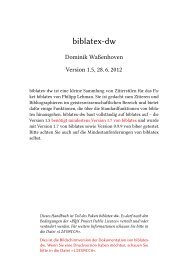pedigree.pdf. - FTP Directory Listing
pedigree.pdf. - FTP Directory Listing
pedigree.pdf. - FTP Directory Listing
You also want an ePaper? Increase the reach of your titles
YUMPU automatically turns print PDFs into web optimized ePapers that Google loves.
Part II<br />
Algorithm Description<br />
5 Introduction<br />
This part is intended for advanced users and is not neccessary for runnuing the<br />
program.<br />
The problem of nicely typesetting graphs is one of the classical problems in<br />
the Computer Science [4]. One of the earliest algorithms here is the classical<br />
algorithm for layered rooted trees by Reingold and Tilford [4, § 3.1]. This<br />
algorithm was implemented by PSTricks [3]. However, many <strong>pedigree</strong>s are not<br />
trees [2]. If we consider a subset of <strong>pedigree</strong>s where inbreeding is absent, the<br />
<strong>pedigree</strong>s become trees. However, even in this case the the tree is not necessary<br />
layered, as can be seen from Figure 1. Therefore a new approach generalizing<br />
Reingold-Tilford algorithm is necessary. This approach is based on the analysis<br />
of the structure of <strong>pedigree</strong>s and is sketched in the remainder of this manual.<br />
6 Main Algorithm<br />
A <strong>pedigree</strong> consists of nodes (vertices), connected by lines (edges). If there is<br />
no inbreeding, the graph is acyclic. There are two kinds of nodes in the graph:<br />
person nodes (squares and circles on Figures 1 and 2) and marriage nodes,<br />
which are nameless on the figures. We will use the notation “male spouse-female<br />
spouse” for such nodes, so the marriage nodes on Figure 1 are I:1-I:2, I:3-I:4<br />
and II:2-II:3. A node has a precedessor and children. A marriage node does not<br />
have a precedessor, but has male spouse and female spouse (it is customary to<br />
put male spouses to the left and female spouses to the right on <strong>pedigree</strong>s). Any<br />
node has a downward tree of its children, grandchildren etc. The downward tree<br />
may be empty.<br />
Any node in an acyclic graph can be a root. However, in layered trees there<br />
is a special root: the one that has no precedessor. Similarly we will call a local<br />
root a node that has no predecessor. All marriage nodes are local roots. Some<br />
person nodes can be local roots as well.<br />
Let us first discuss the case where cobnsanguinic marriages are absent. In<br />
this case a <strong>pedigree</strong> is a tree.<br />
The proposed algorithm is recursive and starts from a local root. Strictly<br />
speaking, it can start from any local root, but medical <strong>pedigree</strong>s have a special<br />
person: proband, the person who was the first to be examined by genetic specialists<br />
(the proband is shown by an arrow drawn near the node on Figures 1<br />
and 2). Therefore it makes sense to start from the local root which has proband<br />
in its downward tree.<br />
If this local root is a person node, the <strong>pedigree</strong> is the layered tree, and<br />
Reingold-Tilford algorithm is sufficient. Therefore we should consider only the<br />
29



